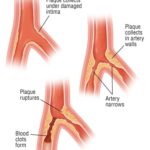1. For patients referred for potential obstructive coronary artery disease (CAD), computed tomography (CT) and invasive coronary angiography (ICA) as a diagnostic tool showed similar rates of major adverse cardiovascular events.
2. Patients assessed by CT experienced fewer major procedural-related complications.
Evidence Rating Level: 1 (Excellent)
Study Rundown: Invasive coronary artery (ICA) is the standard initial modality for diagnosing obstructive coronary artery disease (CAD); however, interest in using computed tomography (CT) for the same indication has grown given its lower rate of major procedure-related complications. Subsequently, the DISCHARGE randomized control trial was conducted to compare the rate of major cardiovascular complications between the two modalities. Patients who were at risk for obstructive CAD (stable chest pain, intermediate pretest probability) were randomized to either CT or ICA, then followed for 3.5 years. The primary outcome was the rate of major adverse cardiovascular events such as death, myocardial infarction, or stroke. Secondary outcomes looked at procedure-related complications and angina pectoris. The study found that while both CT and ICA showed had a similar rate of major cardiovascular events, the ICA group experienced significantly more procedure-related complications. Taken together, this study supports the use of CT as opposed to ICA in diagnosing obstructive CAD in patients with stable chest pain and intermediate pretest probability. The results of this study are limited by its non-blinded design, variance in CAD management decisions between providers, and the fact that cost-effectiveness between imaging modalities was not considered.
Click to read the study in NEJM
In-Depth [randomized controlled trial]: In this multicenter, phase 3 randomized control trial named DISCHARGE (diagnostic imaging strategies for patients with stable chest pain and intermediate risk of coronary artery disease), 3523 patients with stable chest pain and intermediate preterm probability for obstructive coronary artery disease (CAD) were randomized in a 1:1 ratio to either receive diagnostic computed tomography (CT) or invasive coronary angioplasty (ICA) to determine whether revascularization procedures were required. If not, patients were discharged and followed by their primary care physician. The primary outcome was the incidence of major cardiovascular events including cardiovascular-related death, myocardial infarction, or strokes after a median of 3.5 years of follow-up. Secondary outcomes analyzed procedure-related complications within 48 hours of CT or ICA and patient-reported scores on angina. The results of the study found that 2.1% of the CT group and 3.0% of the ICA group experienced a major cardiovascular event (hazard ratio [HR], 0.7; 95% confidence interval [CI], 0.46 to 1.07; P=0.010), indicated no statistical difference between the two diagnostic modalities. However, with respect to the secondary outcome, the CT group experienced significantly fewer procedure-related complications than ICA (HR, 0.26; 95%CI, 0.13 to 0.55). Incidence of patient-reported angina and quality of life did not differ between groups. Overall, the results of this study support the use of CT as an initial diagnostic tool for patients with stable chest pain and intermediate pretest probability of obstructive CAD as they demonstrate similar rates of major cardiovascular events, but a lower rate of procedure-related complications.
Image: PD
©2022 2 Minute Medicine, Inc. All rights reserved. No works may be reproduced without expressed written consent from 2 Minute Medicine, Inc. Inquire about licensing here. No article should be construed as medical advice and is not intended as such by the authors or by 2 Minute Medicine, Inc.


